
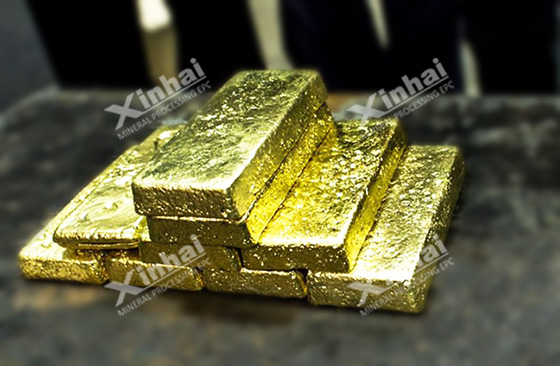
The gold ore has a high mining value, the gold processing technologies are more complex, and the gold processing equipment used is not the same.
At present, the common gold processing technologies mainly include the cyanide leaching method, flotation method and gravity separation method. That is, through the crushing, screening, grinding and classification, the ore is sent to the various gold processing equipment (leaching agitation tank, flotation cell, gravity separator) for separation. The concentrate obtained by the cyanide leaching, gravity separation and flotation are smelted by the chemical methods, and the product is finally made into the finished gold. Below, we will mainly explain the gold processing equipment used in the different stages of gold processing.
Cyanide leaching is one of the main gold processing methods, which can be divided into agitation cyanide leaching and percolation cyanide leaching. Among them, the agitation cyanide leaching process mainly includes the cyanidation-zinc replacement process (CCD method and CCF method) and unfiltered carbon cyanide slurry process (CIP method and CIL method). The common gold processing equipment mainly includes the zinc powder replacement device, leaching agitation tank, desorption electrolysis system.
Zinc powder replacement device is a system to extract the gold from the precious liquid in the zinc powder in the cyanidation-zinc replacement process, which is mainly used to treat the gold ore with more silver. After purifying and deoxidizing the precious liquid, add it to the zinc powder replacement device and then get the gold mud.
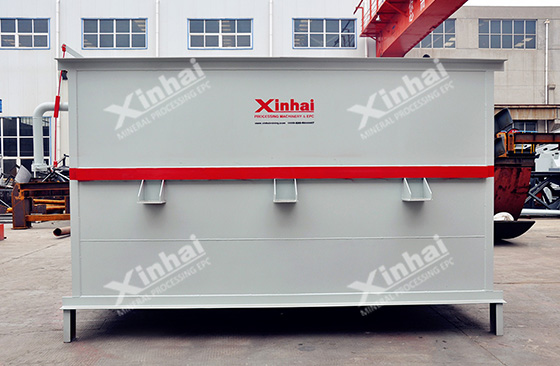
In the production, the gold can be recovered by the zinc powder (wire) replacement precipitation, namely, the cyanide-zinc replacement process (CCD method and CCF method), or the zinc powder replacement can be used to treat the precious liquid (leach solution) in the pool leaching or heap leaching. In addition to the gold ore with high silver content, the zinc powder replacement device can also be used to treat the gold concentrate whose grade needed to be improved.
The leaching agitation tank is a kind of gold processing machine commonly used in the CIP process and CIL process. Under the drag and mixing of the double impeller, the pulp flows from the top to the down in the center. With the proliferation of the damping plate, the air is fed on the lower end of the shaft, mix the pulp and upward, form the uniform suspension mixture. This gold processing equipment is suitable for the gold leaching with small proportion, low viscosity, slow sedimentation velocity, and the ore particle size (-200 mesh) accounts for more than 90%, the pulp density is less than 45%.
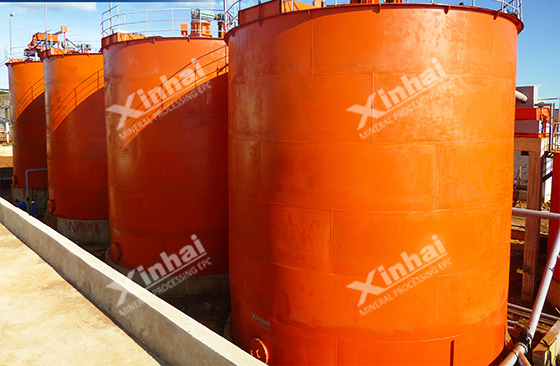
In the CIP process, the leaching and adsorption are separate operations. In the adsorption operation, the leaching process has been basically completed, and the size, number and working conditions of the adsorption tank are determined by the adsorption parameters. In the CIL process, the leaching and adsorption operations are carried out simultaneously. Generally, the leaching operation takes longer than the adsorption operation, so the size, charging and dosing of the leaching agitation tank is determined by the leaching parameters. Since the adsorption rate is a function of the concentration of dissolved gold in the solution, 1-2 stages of pre-leaching are usually added before the immersion and suction in order to improve the concentration of dissolved gold in the front adsorption tank and increase the leaching time.
The desorption electrolysis system is a set of gold processing equipment that obtains the gold mud from the gold-bearing charcoal through the sorption and electrodeposition under the condition of high temperature and high pressure. The gold carbon and slurry are lifted to the carbon separation screen (generally linear vibrating screen) through the carbon lifting pump or air lifter. The screen is washed with clean water to separate the carbon from the slurry. The gold-bearing carbon is carried into the carbon storage tank, the slurry and the flushing water enter the first stage of the adsorption tank. The anion which is easy to be absorbed by the activated carbon is added to the desorption electrolysis system, and then replace the Au(CN) 2-to realize the desorption of gold. The precious liquid obtained by the desorption of gold-bearing carbon is recovered by the ionization to obtain the solid gold.
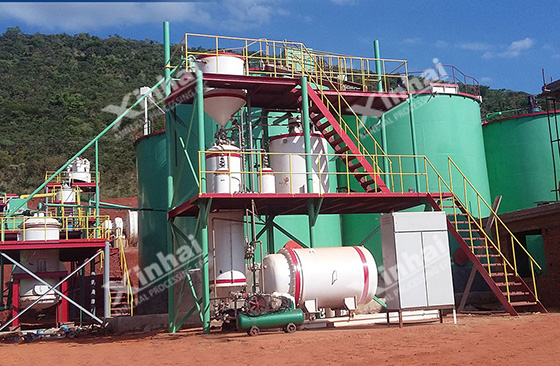
Under the conditions of high temperature (150℃) and high pressure (0.5mpa), the desorption rate of the desorption electrolysis system with high efficiency and low consumption can reach over 98%, and the power consumption is only 1/4~1/2 of that of the conventional system. The non-toxic combination desorption agent contains the carbon activator, which plays the role in carbon regeneration. And the poor carbon doesn’t need fire regeneration, which saves the cost of carbon regeneration. And the gold mud has a high grade, which doesn’t need oanti-electrolysis. At the same time, the desorption electrolysis system has triple safety protection measures, namely the system intelligence, automatic pressure limit, pressure release mechanism, safety valve.
The flotation process is a gold processing method widely used in the gold concentrator, it is often used to treat the sulfide gold minerals with high flotability. This gold processing method is to float the gold into the copper, lead concentrate, and then extract the gold from the ore concentrate. The gold processing equipment used in the flotation method is the various types of air suction mechanical stirring floatation cell (SF flotation cell, BF flotation cell, JJF flotation cell) and air-inflation mechanical agitation floatation cell (KYF flotation cell, XCF flotation cell).
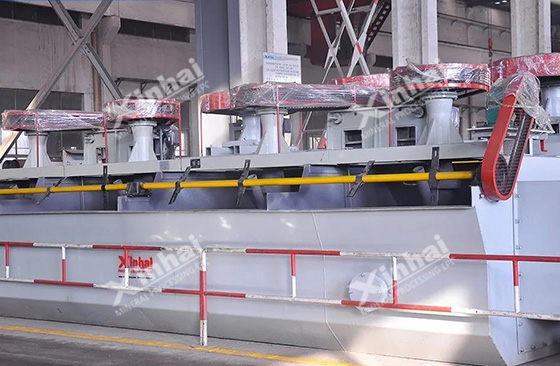
In the practical application, the self-air suction mechanical stirring floatation cell can be used for the flotation process with the small air impact. The medium and small-scale gold ore concentrators can adopt air-inflation mechanical agitation floatation cells with slurry suction tanks or self-air suction mechanical stirring floatation cells. For the large-scale, super large gold ore concentrator, the roughing and scavenging can choose inflatable mechanical stirring floatation cells.
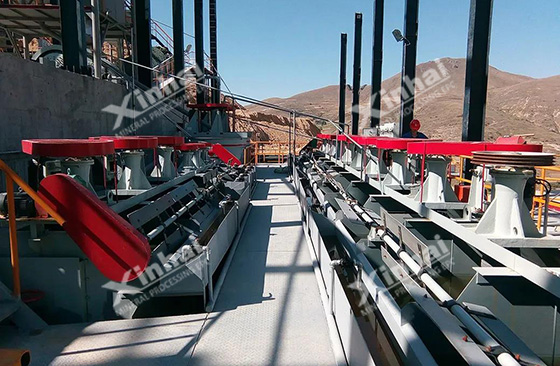
In addition, the gold concentrator can choose the flotation unit composed of KYF and XCF flotation cell according to its own situation. Among them, XCF flotation cell is used as the suction tank and KYF flotation cell is used as the DC tank to achieve the horizontal configuration without the foam pump. The U-shaped tank design makes the flotation distance as short as possible, the slurry flows to the bottom of the tank, and the rotor is pumped to the clearance between the impeller and the stator, which is conducive to the return of the heavy ore to the impeller area for recirculation, avoiding the accumulation of ore and reducing the slurry short-circuit phenomenon. The combined flotation unit can not only provide a new way for the flotation machine configuration of the new gold concentrator, but also provide an economical and easy way for the reconstruction of the flotation process of the old concentrator.
For gold processing, the gravity separation method is one of the common methods in gold recovery, which is to separate the materials by different specific gravity and different settling velocity in the medium, which is used in separating the alluvial gold and lode gold. the common gold processing equipment used in the gravity separation method mainly includes jig, shaking table and the spiral chute.
The jigging process is to mix the mineral particles with different specific gravity and stratify them according to the specific gravity in the variable speed medium flow with vertical movement. The minerals with small specific gravity are in the upper layer, while the minerals with large specific gravity are in the lower layer. The layered materials are discharged separately by means of machinery and water flow.
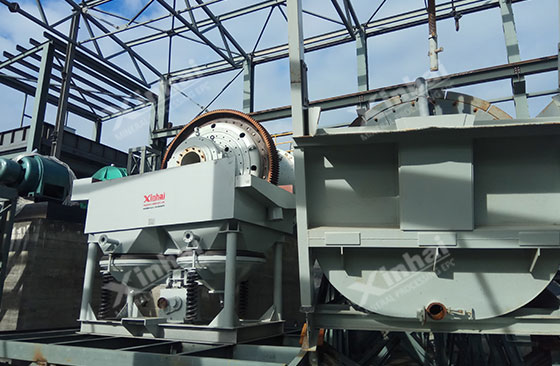
The jig is suitable for the separation of coarse mineral particles (any raw mineral materials except for superfine material mineral). For the placer gold ore, the lower limit of beneficiation size is 0.04 mm if the proportion difference is equal to or larger than 1.25, and the ore achieves the monomer dissociation. Gravity separation by jigging used for gold recovery is featured with simple process operation, large equipment processing capacity, which is widely applied in the roughing gold recovery.
The shaking table is a kind of gold processing equipment for separation of different weight mineral by asymmetric reciprocating motion. The working principle of the gold shaking table is to use the combined action of the specific gravity difference of sorted minerals, alternating movement of bed surface, and transverse oblique water flow and riffle (or notch groove), to allow loose layering of ores on the bed surface and fan-shaped zoning. Then different products can be produced.
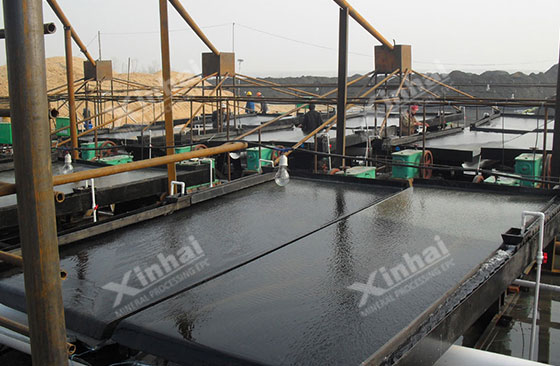
The shaking table is suitable for the gold mineral with fine particles. According to the different particle sizes, the ore can be divided into a coarse sand bed, fine sand bed and slurry bed. The coarse sand bed is suitable for the material particle size between 2.0 mm to 0.5 mm, the fine sand bed is suitable for processing material particle size between 0.5 mm to 0.074 mm, the slurry bed is suitable for processing the material particle size between 0.074 mm to 0.037 mm.
The spiral chute is a kind of gold processing equipment with the help of ramp flow. The material particles settle on the different zone of chute under the joint force of water flow, mineral gravity, frictions between mineral grain and chute bottom. The particles with a small proportion are taken away by the water flow, and the particles with a large proportion are left. The spiral chute is suitable for the treatment of micro-grained materials with low mud content. The particle size range is 0.6 mm-0.03mm. Gravity separation by spiral chute used for gold recovery is featured with simple structure, large processing capacity and low comprehensive cost.
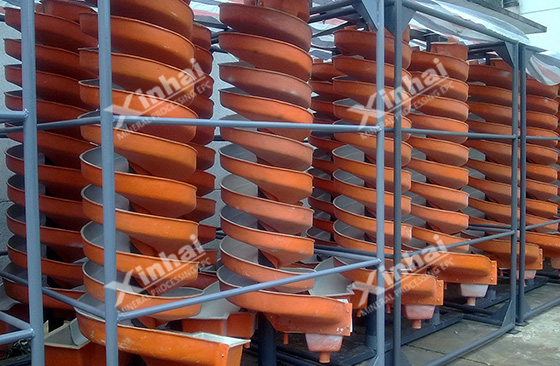
In addition, some gold processing plants often use the combined gold processing methods to extract gold ores, such as the combined process of gravity separation-cyanide leaching, gravity separation-flotation process, flotation-gravity separation combined process. The gold processing equipment used in the different separation stage can be selected for reference according to the plant’s actual situation, ore properties and other factors.
The gold ore resources are very precious. In order to separate the ore more reasonably, the gold processing technology and gold processing equipment are very important. It is suggested to carry on the mineral processing test for the comprehensive analysis of the nature of the ore. And the gold processing technology and gold processing equipment are determined according to the scientific ore beneficiation test report, thus to achieve the best return on investment.
The production practice has proved that reducing the failure of the pinion and bearing of the rod mill plays an important role in ensuring the continuous operation of the system and reducing the cost pressure. Here are the main causes of pinion failure and bearing failure, and their corresponding solutions.
Thickening and sedimentation is an important part of the mineral processing plant. With the improvement of processing requirements, the traditional thickener has obvious problems, such as slow settling speed, easy to be muddy, low processing capacity, etc. According to the above problems, Xinhai keeps improving thickener, combining with processing technology, improving sedimentation efficiency, reducing muddy probability, and reducing equipment operation cost.
